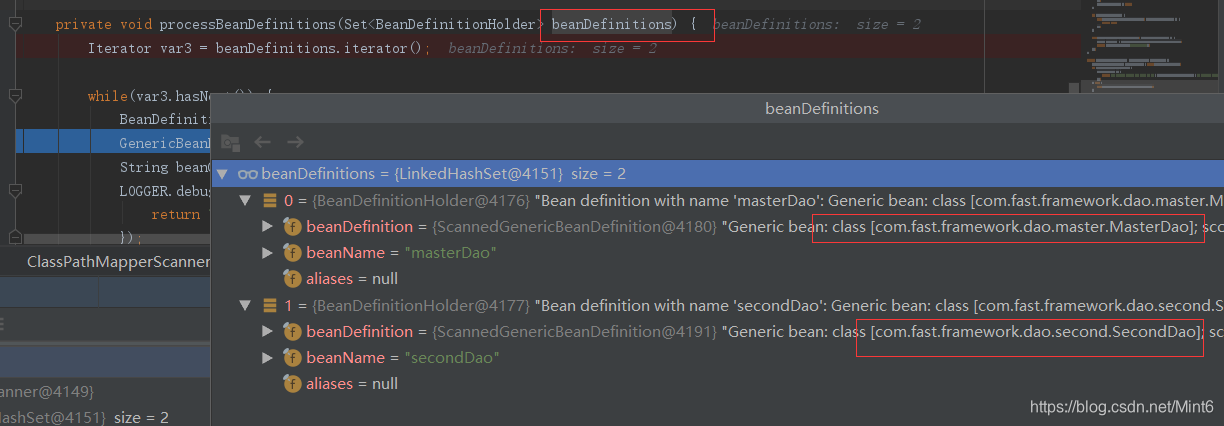Foreword : In fact, it is generally not written such an analysis, because after learning the analysis process, you know that writing such a blog feels like water. But this time, one is to record the analysis process, and the other is to share with you the process of @MapperScan annotation scanning package.
Ask a question : @MapperScan("com.fast") scans the beans under the com.fast package. There is no doubt, but does it include the beans under the subpackage?
Question case : For example, com.fast.master.dao, and com.fast.second.dao, will the beans under these packages be scanned together?
Start analysis :
1. Check the MapperScan annotation, when scanning the package, this is mainly @Import({MapperScannerRegistrar.class})
@Retention(RetentionPolicy.RUNTIME)
@Target({ElementType.TYPE})
@Documented
@Import({MapperScannerRegistrar.class})
@Repeatable(MapperScans.class)
public @interface MapperScan {
String[] value() default {};
String[] basePackages() default {};
Class<?>[] basePackageClasses() default {};
Class<? extends BeanNameGenerator> nameGenerator() default BeanNameGenerator.class;
Class<? extends Annotation> annotationClass() default Annotation.class;
Class<?> markerInterface() default Class.class;
String sqlSessionTemplateRef() default "";
String sqlSessionFactoryRef() default "";
Class<? extends MapperFactoryBean> factoryBean() default MapperFactoryBean.class;
}
2. Find MapperScannerRegistrar.class to see the implementation process, not all of them are posted, mainly this annotation
void registerBeanDefinitions(AnnotationAttributes annoAttrs, BeanDefinitionRegistry registry) {
ClassPathMapperScanner scanner = new ClassPathMapperScanner(registry);
Optional var10000 = Optional.ofNullable(this.resourceLoader);
Objects.requireNonNull(scanner);
var10000.ifPresent(scanner::setResourceLoader);
Class<? extends Annotation> annotationClass = annoAttrs.getClass("annotationClass");
if (!Annotation.class.equals(annotationClass)) {
scanner.setAnnotationClass(annotationClass);
}
Class<?> markerInterface = annoAttrs.getClass("markerInterface");
if (!Class.class.equals(markerInterface)) {
scanner.setMarkerInterface(markerInterface);
}
Class<? extends BeanNameGenerator> generatorClass = annoAttrs.getClass("nameGenerator");
if (!BeanNameGenerator.class.equals(generatorClass)) {
scanner.setBeanNameGenerator((BeanNameGenerator)BeanUtils.instantiateClass(generatorClass));
}
Class<? extends MapperFactoryBean> mapperFactoryBeanClass = annoAttrs.getClass("factoryBean");
if (!MapperFactoryBean.class.equals(mapperFactoryBeanClass)) {
scanner.setMapperFactoryBeanClass(mapperFactoryBeanClass);
}
scanner.setSqlSessionTemplateBeanName(annoAttrs.getString("sqlSessionTemplateRef"));
scanner.setSqlSessionFactoryBeanName(annoAttrs.getString("sqlSessionFactoryRef"));
List<String> basePackages = new ArrayList();
basePackages.addAll((Collection)Arrays.stream(annoAttrs.getStringArray("value")).filter(StringUtils::hasText).collect(Collectors.toList()));
basePackages.addAll((Collection)Arrays.stream(annoAttrs.getStringArray("basePackages")).filter(StringUtils::hasText).collect(Collectors.toList()));
basePackages.addAll((Collection)Arrays.stream(annoAttrs.getClassArray("basePackageClasses")).map(ClassUtils::getPackageName).collect(Collectors.toList()));
scanner.registerFilters();
scanner.doScan(StringUtils.toStringArray(basePackages));
}Are you familiar with this sentence? It is the annotations implemented by MapperScan, value, basePackages, basePackageClasses.
basePackages.addAll((Collection)Arrays.stream(annoAttrs.getStringArray("value")).filter(StringUtils::hasText).collect(Collectors.toList()));
basePackages.addAll((Collection)Arrays.stream(annoAttrs.getStringArray("basePackages")).filter(StringUtils::hasText).collect(Collectors.toList()));
basePackages.addAll((Collection)Arrays.stream(annoAttrs.getClassArray("basePackageClasses")).map(ClassUtils::getPackageName).collect(Collectors.toList()));
scanner.registerFilters();
scanner.doScan(StringUtils.toStringArray(basePackages));Enter from the sentence scanner.doScan, here is the place to start scanning the package
3. Open the called method
private void processBeanDefinitions(Set<BeanDefinitionHolder> beanDefinitions) {
Iterator var3 = beanDefinitions.iterator();
while(var3.hasNext()) {
BeanDefinitionHolder holder = (BeanDefinitionHolder)var3.next();
GenericBeanDefinition definition = (GenericBeanDefinition)holder.getBeanDefinition();
String beanClassName = definition.getBeanClassName();
LOGGER.debug(() -> {
return "Creating MapperFactoryBean with name '" + holder.getBeanName() + "' and '" + beanClassName + "' mapperInterface";
});
definition.getConstructorArgumentValues().addGenericArgumentValue(beanClassName);
definition.setBeanClass(this.mapperFactoryBeanClass);
definition.getPropertyValues().add("addToConfig", this.addToConfig);
boolean explicitFactoryUsed = false;
if (StringUtils.hasText(this.sqlSessionFactoryBeanName)) {
definition.getPropertyValues().add("sqlSessionFactory", new RuntimeBeanReference(this.sqlSessionFactoryBeanName));
explicitFactoryUsed = true;
} else if (this.sqlSessionFactory != null) {
definition.getPropertyValues().add("sqlSessionFactory", this.sqlSessionFactory);
explicitFactoryUsed = true;
}
if (StringUtils.hasText(this.sqlSessionTemplateBeanName)) {
if (explicitFactoryUsed) {
LOGGER.warn(() -> {
return "Cannot use both: sqlSessionTemplate and sqlSessionFactory together. sqlSessionFactory is ignored.";
});
}
definition.getPropertyValues().add("sqlSessionTemplate", new RuntimeBeanReference(this.sqlSessionTemplateBeanName));
explicitFactoryUsed = true;
} else if (this.sqlSessionTemplate != null) {
if (explicitFactoryUsed) {
LOGGER.warn(() -> {
return "Cannot use both: sqlSessionTemplate and sqlSessionFactory together. sqlSessionFactory is ignored.";
});
}
definition.getPropertyValues().add("sqlSessionTemplate", this.sqlSessionTemplate);
explicitFactoryUsed = true;
}
if (!explicitFactoryUsed) {
LOGGER.debug(() -> {
return "Enabling autowire by type for MapperFactoryBean with name '" + holder.getBeanName() + "'.";
});
definition.setAutowireMode(2);
}
}
}4. Start debugging from the first line of this method. Here I use @MapperScan("com.fast.framework.dao") to scan the com.fast.framework.dao package

This is the scanned package, indicating that the sub-package will be scanned, perfect. Solved the problems raised at the beginning.

Summary: In fact, the analysis process here is not particularly detailed, because here is to prove the scanned package, which indirectly proves that the scanned package will be used. The rest: How to scan all the packages in the previous step , and how to initialize the scan to the package are not analyzed in detail. So it is also Xiaoshui's article, mainly to understand that the @MapperScan annotation will scan the sub-packages of the package and learn this analysis idea .